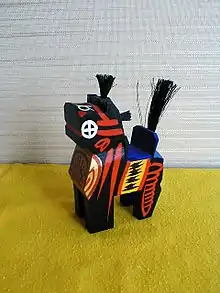Miharu-goma
Miharu-goma (三春駒) are angular, brightly coloured, wooden toy horses produced as a folk art in Miharu, Fukushima, Japan.

Miharu-goma
Over View
Such toys have their origins in a legend concerning Sakanoue no Tamuramaro. According to the legend, he either received aid from a magical wooden horse[1] or was able to win a battle due to the timely appearance of a herd of wild horses.[2] Due to the original toys being carved from offcuts of Buddhist images, Miharu-goma have always had superstitions attached to them.[3] Although commonly made of painted wood, they are sometimes constructed from straw or even paper. They are said to be able to carry messages to the gods on behalf of petitioners.[4]Miharu-goma have existed in Japan for around 1500 years.[3]
References
- "三春駒 Miharugoma Miharu-goma Horse Toys". Nippon-kichi. Retrieved June 18, 2012.
- "Japanese Child's Charm: "Miharu-goma"". Mobile Museum. Connecting Cultures. Retrieved 23 October 2014.
- Gakuyō Shobō (1962). Japanese interiors. Gakuyō Shobō. p. 86. Retrieved 18 June 2012.
- Louis Frédéric (2002). Japan Encyclopedia. Harvard University Press. p. 628. ISBN 978-0-674-01753-5. Retrieved 18 June 2012.
This article is issued from Wikipedia. The text is licensed under Creative Commons - Attribution - Sharealike. Additional terms may apply for the media files.